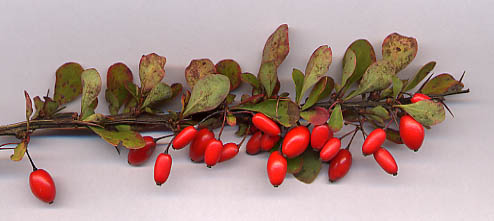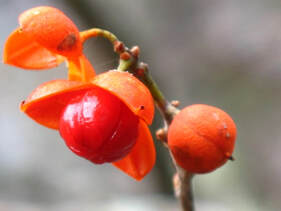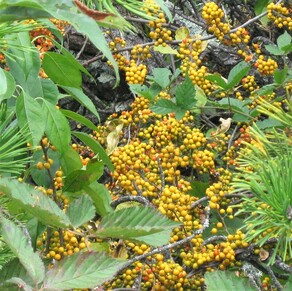The Problem with Nonnative Invasive Plants
A non-native plant is one that is growing in a place other than its natural habitat. Non-native plants can refer to plants that grow naturally in North America but are out of their natural place as well as plants from other places around the globe.
Some non-native plants were introduced accidentally, while others were brought for food, forage, as medicines or ornamentals. Plant seeds have traveled long distances in hay stored as food for livestock on ships (and later discarded at a port); in packing materials used for china and other fragile goods; on hikers boots and horses hooves; on wind currents, and numerous other ways. Many plants are carried intentionally from one area to another, as favored foods or ornamental plants.
Not all non-native plants are undesirable. Those that take root quickly and begin to spread aggressively, establishing themselves over large areas and choking out other, more suitable and more desirable plants, are the ones generally called non-native invasive species. These plants often arrive without the natural predators that tend to keep plant communities in natural balance. Once established, they can be difficult to remove.
An estimated 3,500 species of non-native plants have escaped cultivation in the U.S. Some are now so widespread that they are mistaken as native. Many (think kudzu!) pose a serious threat to native plants and ecosystems. Others, such as Queen Anne’s Lace, are naturalized without interfering with the growth of native plants; they can, however, completely take over a field or meadow.
The worst species in North Carolina, from the NC Natural Heritage Program.
This list was downloaded in 2015, so others have likely been added more recently. I'll check on that soon!
This list was downloaded in 2015, so others have likely been added more recently. I'll check on that soon!
Rank 1 – Severe Threat: Exotic plant species that have invasive characteristics and spread readily into native plant communities, displacing native vegetation.
Scientific Name
Common Name
Ailanthus altissima (Mill.) Swingle. Tree of Heaven
Albizia julibrissin Durz., Mimosa
Alliaria petiolata (Bieb.) Cavara & Grande, Garlic-mustard
Alternanthera philoxeroides (Mart.) Griseb., Alligatorweed
Celastrus orbiculatus Thunb., Asian bittersweet
Elaeagnus angustifolia L., Russian olive
Elaeagnus umbellata Thunb., Autumn olive
Hedera helix L., English ivy
Hydrilla verticillata (L.f.) Royle, Hydrilla
Lespedeza bicolor Turczaninow, Bicolor lespedeza
Lespedeza cuneata (Dum.-Cours.) G. Don, Sericea lespedeza
Ligustrum sinense Lour., Chinese privet
Lonicera fragrantissima Lindl. & Paxton, Fragrant honeysuckle
Lonicera japonica Thunb. ,Japanese honeysuckle
Microstegium vimineum (Trin.) A. Camus, Japanese stilt-grass
Murdannia keisak (Hassk.) Hand.-Mazz., Asian spiderwort
Myriophyllum aquaticum (Vell.) Verdc. ,Parrotfeather
Paulownia tomentosa (Thunb.) Sieb.& Zucc. ex Steud.. Princess tree
Persicaria perfoliata (Linnaeus) H. Gross (=Polygonum perfoliatum L.), Mile-a-minute vine
Phragmites australis (Cav.) Trin. ssp. australis , Common reed
Pyrus calleryana Decne., Bradford pear
Reynoutria japonica Houttuyn (Polygonum cuspidatum), Japanese knotweed
Pueraria montana (Lour.) Merr., Kudzu
Rosa multiflora Thunb.. Multiflora rose
Salvinia molesta Mitchell, Aquarium water-moss
Vitex rotundifolia L.f. ,Beach vitex
Wisteria sinensis (Sims) DC, Chinese wisteria
Scientific Name
Common Name
Ailanthus altissima (Mill.) Swingle. Tree of Heaven
Albizia julibrissin Durz., Mimosa
Alliaria petiolata (Bieb.) Cavara & Grande, Garlic-mustard
Alternanthera philoxeroides (Mart.) Griseb., Alligatorweed
Celastrus orbiculatus Thunb., Asian bittersweet
Elaeagnus angustifolia L., Russian olive
Elaeagnus umbellata Thunb., Autumn olive
Hedera helix L., English ivy
Hydrilla verticillata (L.f.) Royle, Hydrilla
Lespedeza bicolor Turczaninow, Bicolor lespedeza
Lespedeza cuneata (Dum.-Cours.) G. Don, Sericea lespedeza
Ligustrum sinense Lour., Chinese privet
Lonicera fragrantissima Lindl. & Paxton, Fragrant honeysuckle
Lonicera japonica Thunb. ,Japanese honeysuckle
Microstegium vimineum (Trin.) A. Camus, Japanese stilt-grass
Murdannia keisak (Hassk.) Hand.-Mazz., Asian spiderwort
Myriophyllum aquaticum (Vell.) Verdc. ,Parrotfeather
Paulownia tomentosa (Thunb.) Sieb.& Zucc. ex Steud.. Princess tree
Persicaria perfoliata (Linnaeus) H. Gross (=Polygonum perfoliatum L.), Mile-a-minute vine
Phragmites australis (Cav.) Trin. ssp. australis , Common reed
Pyrus calleryana Decne., Bradford pear
Reynoutria japonica Houttuyn (Polygonum cuspidatum), Japanese knotweed
Pueraria montana (Lour.) Merr., Kudzu
Rosa multiflora Thunb.. Multiflora rose
Salvinia molesta Mitchell, Aquarium water-moss
Vitex rotundifolia L.f. ,Beach vitex
Wisteria sinensis (Sims) DC, Chinese wisteria
|
Non-native Invasive species
Japanese barberry, Berberis thunbergii. A pretty shrub 4' tall and 7' wide, with burgundy leaves and tiny yellow flowers that line the bottoms of stems. Red fruits (seeds) appear in Autumn and are favored by birds, who then drop them to germinate elsewhere. They can form dense colonies, all with thorns, and crowd out native plant species. This alters the ecosystem and can even change the soil type. Pennsylvania banned sale of the plants in 2021. |
Suggested Alternatives
Winterberry holly, Ilex verticillata New Jersey tea, Ceanothus americanus Bayberry, Myrica pensylvanica Wild hydrangea, Hydrangea arborescens Red chokeberry, Aronia arbutifolia |
Bittersweet, Celastrus scandens VS Asian bittersweet, Celastrus orbiculatusAsian bittersweet can be an attractive climbing vine, especially to crafters. The problem is that it is an aggressive spreader AND it crosses easily with our native bittersweet, Celastrus scandens. When it crosses, the hybrids are fertile and tend to dominate the native species, which are now on the decline.
The two species can be difficult to tell apart. One way to distinguish them is that the native bittersweet carries its fruits and flowers mostly at the end of a stem. The Asian bittersweet has its fruits and flowers in the leaf axils. Asian bittersweet was brought to this country in 1860 as an ornamental plant and for use in erosion control. By 2008 it covered nearly 9,000 acres of forest in the Southeast, including in Guilford County. The thick rooted plants can sprawl so far and so densely that they form a nearly impenetrable thicket. |
What does this mean to me?
Invasive plants can alter the natural balance of ecosystems. They can choke out native plants and wildlife habitat, thus endangering the survival of animal and insect species. They displace rare plant species and reduce overall biodiversity, the greatest cause of species extinctions worldwide. Invasive plants also degrade the scenic, agricultural and recreational value of the land.
What you can do.
Consider using native alternatives to invasive species in your landscape.
Remove invasive plants that are already on your property. Left where they are, they will spread in your yard, to your neighbors, and to nearby forests and open areas.
Learn more about non-native invasive plants and share that information with your neighbors.
Native Herb Conservation Committee, The Herb Society of America, Inc.


